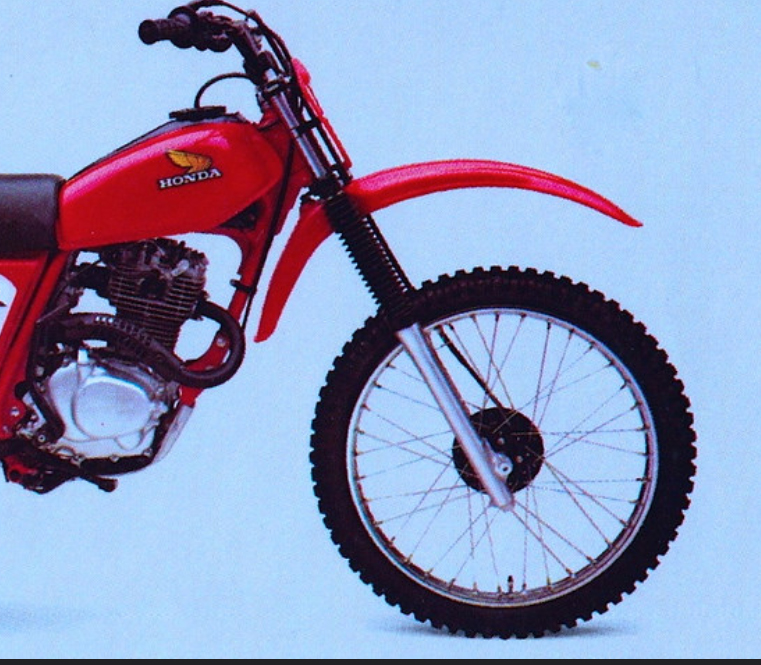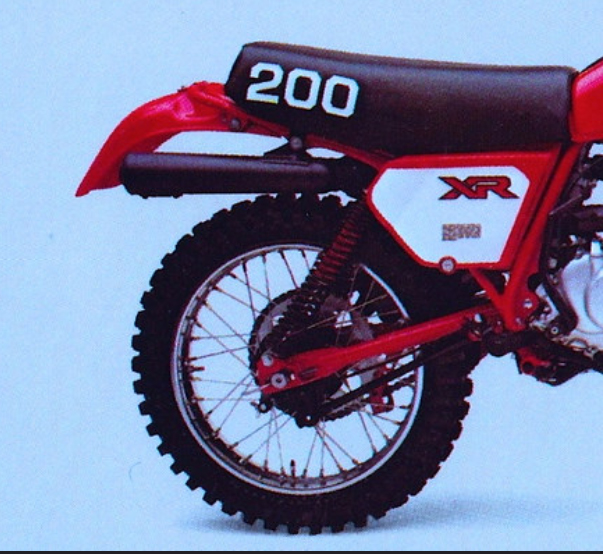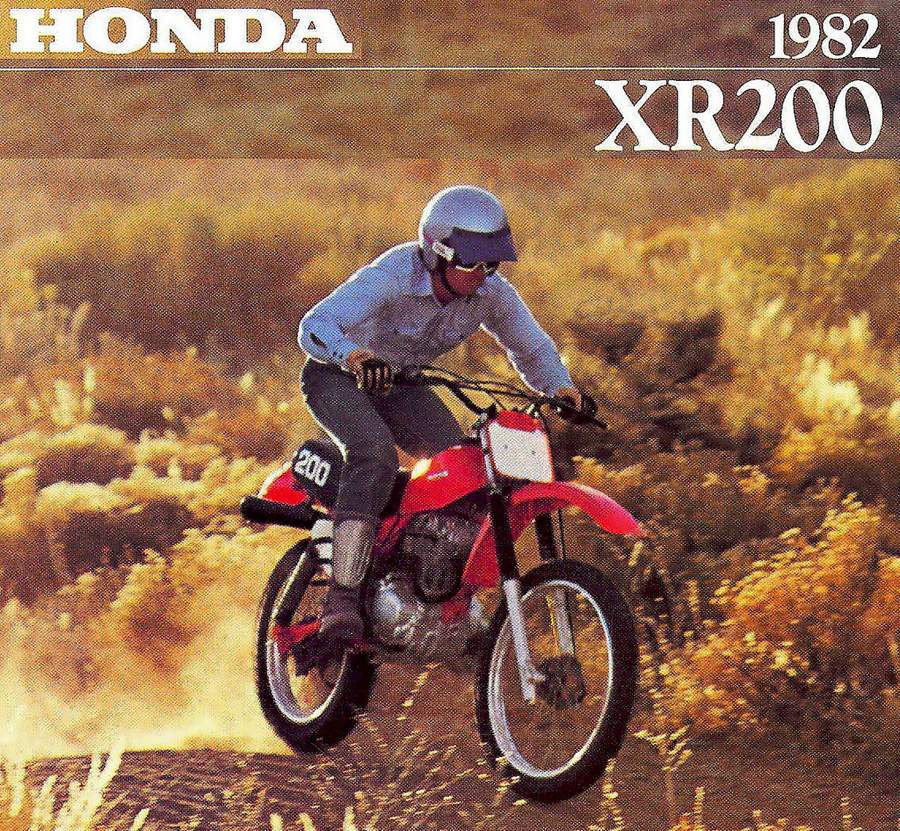
|
|
|
|
|
|
Classic Bikes
Custom Bikes
Individual
Racing Bikes AJP
AJS
Aprilia
Ariel
Avinton / Wakan
Bajaj
Benelli
Beta
Bimota
BMW
Brough Superior
BRP Cam-Am
BSA
Buell / EBR
Bultaco
Cagiva
Campagna
CCM
CF Moto
Combat Motors
Derbi
Deus
Ducati
Excelsior
GASGAS
Ghezzi Brian
Gilera
GIMA
Harley Davidson
Hero
Highland
Honda
Horex
Husaberg
Husqvarna
Hyosung
Indian
Jawa
Kawasaki
KTM
KYMCO
Laverda
Lazareth
Magni
Maico
Mash
Matchless
Mondial
Moto Guzzi
Moto Morini
MV Agusta
MZ / MuZ
NCR
Norton
NSU
Paton
Peugeot
Piaggio
Revival Cycles
Roland Sands
Royal Enfield
Sachs
Sherco
Sunbeam
Suzuki
SWM
SYM
Triumph
TVS
Ural
Velocette
Vespa
Victory
Vincent
VOR
Voxan
Vyrus
Walt Siegl
Walz
Wrenchmonkees
Wunderlich
XTR / Radical
Yamaha
Zero
Video
Technical
Complete Manufacturer List
|
Honda XR 200
|
| . |
|
Make Model |
Honda XR 200 / R |
|
Year |
1982 |
|
Engine |
Four stroke, single cylinder, SOHC, 2 valve |
|
Capacity |
195.6 cc / 11.9 cu-in |
| Bore x Stroke | 65.5 x 57.8 mm |
| Cooling System | Air cooled |
| Compression Ratio | 10.0:1 |
|
Induction |
Single 26mm Keihin carburettor |
|
Ignition |
CDI |
| Starting | Kick |
|
Max Power |
11.8 hp / 8.8 KW @ 8000 rpm |
|
Max Torque |
12.3 lb-ft / 16.7 Nm @ 6500rpm |
|
Transmission |
6 Speed |
| Final Drive | Chain |
| Front Suspension | 35 mm Kayaba forks |
| Front Wheel Travel | 240 mm / 9.4 in |
| Rear Suspension | Pro-link Kayaba damper adjustment for spring preload and rebound damping |
| Rear Wheel Travel | 190.5 mm / 7.5 in |
|
Front Brakes |
Drum |
|
Rear Brakes |
Drum |
|
Front Tyre |
3.00-21 |
|
Rear Tyre |
4.10-18 |
| Dimensions |
Length 2135 mm / 84.06 in Width 840 mm / 33.07 in Height 1176 mm / 46.3 in |
| Wheelbase | 1320 mm / 52 in |
| Seat Height | 864 mm / 34 in |
|
Dry Weight |
109 kg / 240.5 lbs |
|
Fuel Capacity |
7.5 Litres / 2.0 US gal |
|
Top Speed |
102 km/h |
| . |
The XR200'82 1982 came in just one color: Tahitian Red. The "XR" side cover decal was red on a white panel. The frame was red, but the engine was silver. The speedometer was deleted along with the rear toolbag. The seat was black with a white "200" graphic. The fuel tank was steel. It featured a twin-shock rear treatment and steel rims. The engine was an OHC, 2-valve, single cylinder displacing 195cc linked to a 6- speed transmission. The serial number began JH2ME0205CK300004.
The XR200R'82 came in just one color: Tahitian Red. The white "XR" decal was located just forward of the white number plate panel. The front number panel was also white. The headlight cowl was black. The frame was red, but the engine was black with polished Link titlefins. The seat was black with a white "200R" graphic and a black tool bag on the back. The fuel tank was plastic. It featured a pro-link rear suspension. The engine was an OHC, 2-valve, single cylinder displacing 195cc linked to a 6-speed transmission. The serial number began JH2ME0400CK100001.

Road Test Cycle 1980
Most of the engine changes follow what Honda did during the '79 model year as customer-installed kits. By increasing the bore from 63 to 65.5mm, the displacement goes up to 195cc, while the stroke is still 57.8mm. The piston and combustion chamber are revised to keep the compression ratio at 10:1, which is as high as any engine should go in these days of questionable gasoline, so the larger engine gains 1 bhp, from 18 to 19, and the displacement in effect makes the camshaft timing milder, which broadens the torque curve.
Enlarging the engine to 195cc might seem to blur the distinction between the 200 and Honda's own 250. It doesn't, though. The 250 is built like the XR500 and feels like a 500 with less power. The XR200, is based on the smaller 125 engine without the counterrotating balancer shaft or four-valve head. The differences make the 200 feel as separate from the XR250 as it is from the two-stroke enduro bikes.
There's more torque gain than power gain, so Honda beefed the clutch—with springs from the old XL350, which should be more than adequate for the job—and upgraded the lining material. The drive chain is now a #520, again in the interest of keeping the torque in harness.
With more power on tap, low gear doesn't have to be quite as low, and the six-speed gearbox gets a higher first gear.
Not as impressive a change is the new chain guide. It's not a roller or a tensioner, but consists of thin steel, weakened by lightening holes, and shaped so it keeps brush off the chain, but does no other work.

XR200 wheels are 18 in. rear and 21 in. front. A disguised advantage, for some uses, as although the 200 doesn't get the 23-in. front wheels fitted to the 250 and 500, it does get the Honda-designed claw-action tires. For those who like the tires, it's a bonus. For those who don't like the tires, the conventional smaller front wheel means there's a wide choice of treads when it comes time for replacement.
The 200 gets non-lipped aluminum rims laced to hubs via small spokes. The spokes look too small for heavy duty riding but we didn't have any break and they only loosened once. The brakes are predictable and the right. size for the machine. They give smooth stops, wet or dry and the rear doesn't chatter. Both axles have pull bars and rear wheel removal has been simplified by reducing the number of spacers and changing the rear wheel adjuster design.
Other changes are motocross lever pivots and kill button. The kill button is a simple push-to-stop type that takes the place of the run/off switch. Levers are a new dog-leg shape with ball ends but they aren't like normal ball end levers.
The ball is offset, so to speak. It's behind the center of the lever end. This presents a smooth front, while still giving some protection in case the bike falls. The smooth front will reduce the chances of snagging a bar in the bushes, which is why Honda did it. Their engineers are proud of the idea. We admire the thought, but found it difficult to get used to. For riders who are accustomed to having the ball in the center, the lever feels like it has a broken end lever. Perhaps with practice we'll come to appreciate the design.
In last year's XR185 test, we complained about the tool roll being hard to hook into the tool bag. For 1980 the rear fender mounted tool bag has a new hold down strap, and the selection of tools has been discarded in favor of a Honda designed tool that combines several wrench sizes and the spark plug wrench all in one piece. This multipurpose tool slides into a pouch in the top cover of the bag, leaving room for a large assortment of spare parts or additional tools in the bottom of the bag. The stretch rubber hold down is gone and a nylon strap with D-rings makes it easier to secure items to the formed plastic bottom of the bag. Another change is the removal of the snaps at the edge of the cover. They used to break the second time they were used, so Honda left them off the new model, since they weren't necessary anyway.
Although the seat looks the same, Honda has reshaped it, lowering the height slightly.
The designers at Honda are masters at making stamped frames look like full tube units. Until the gas tank is removed, you can't be sure. The backbone and brace are stamped from sheet steel, then welded to tubes to complete the frame. Like larger XRs, the engine serves as the lower part of the frame with a formed aluminum skid plate protecting the engine cases from rocks and stumps. Triangulation under the seat is good and several stampings tie the seat rails together. The single front downtube looks rather small but we haven't seen any broken. The rear loop serves as a grab handle of sorts; the rear fender is slightly dented at each side for clearance but a couple of fingers are all that fit.
All of the necessary parts are on the XR200: folding brake and shift lever, the kick pedal is ribbed to prevent slipping, fenders are plastic and keep mud and water off the rider, the speedo has a resettable odometer, and the exhaust is quiet and forest legal.
The XR200 is a small bike by current enduro standards. Seat height is under 34 in. and wheelbase is a short 52 in. When compared to the new Kawasaki KDX175 Uni-Trak (58 in. wheelbase and 37 in. seat height), it becomes apparent Honda and Kawasaki approached the 200cc enduro market from different directions. Honda's low seat height allows shorter riders the pleasure of being able to touch the ground. Real handy when on a side slope, and stuck on a rock.

When the XR200 is parked next to the latest enduro machines from other manufacturers, it looks less serious. It is lower. shorter and generally smaller. It has the right proportions for a play bike, hut doesn't comply with the accepted dimensions the others have determined are correct for a serious enduro mount. And it may be one of the all-time greats for play riding. It will idle around all day, starts easily, has a low seat height, almost all sized riders fit, and best of all, it is quiet.
Until a XR200 rider gets to swap on and off with someone on a good conventional enduro bike, it's impossible to imagine how different the XR is from a K DX or PE or IT. Super quick steering makes the XR the lightest 234 lb. motorcycle around. The low center of gravity means little effort is needed to flick the XR back and forth on a gnarly, tight trail. Tall riders were cramped on the XR at first, but appreciated how close the ground was when the XR had to be wrestled through a tricky spot.
Serious enduro competitors might pass by the 200 with little more than a quick glance, because most are regimented to believe more is best. But the Honda's lesser measurements are a bonus when it's rained for two weeks prior to the run, or the event is going to be run in deep forests and brushy creek bottoms, or in any situation where agility becomes more important than total suspension travel.
The engine's broad power band and six-speed transmission are perfect in the woods. Power is plentiful with no explosiveness or surges and the small fuel tank will carry the rider 80 to 100 miles.
The XR200 isn't perfect, few things are. Three or four kicks are required to start a cold engine, it may die several times before it warms up, and warm up is slow. Once warm, one kick will usually do. Finding neutral is easy while the engine is running, even when the bike is standing still. Finding it with the motor shut off is a real hassle. The trick multi-purpose six-day wrench is a neat idea but . . . it is made from extremely poor metal. We used it to adjust the bars, which stretched it out of size, making it worthless. A foam air cleaner does a good job but it is rather small, meaning it will need to be cleaned often.
Front suspension is via leading axle Showas. Travel is 8.5 inches, stanchion tube diameter is a somewhat small 31mm. Rear suspension is controlled by canted air/oil Showa shocks that mount over the rear axle. Rear wheel travel is 7.5 in. The total suspension package can't he considered trick, or novel, or great. The forks aren't air adjustable, and offer limited travel, but do an excellent job for such short travel units. The shocks aren't re-buildable and use only one progressive spring that is too stiff for riders who weigh less than 140 lb., Works or Öhlins. they're not, but most buyers will probably find them acceptable.
Suspension travel and quality are fine for slow woods use, a hit on the short side for high speed cross country bashing. Whoops are crossed straight and the rider doesn't have to fight for control until higher speeds are reached and the bike starts bottoming, then it's best to slow down. For fast desert riders the XR200 needs more travel, for mountains and general play use, the travel is adequate and the pleasure of being able to touch the ground off-sets the lack of total travel.
So what is the XR200? Is it a play hike? A serious enduro mount? Actually it is a little, no, a lot of both. Everyone who rode the little 200 thought it was one of the most fun hikes they had ever ridden. When we took the XR into the woods and tight trails it surprised everyone by smoking most of the 250s and 400s. It was plainly quicker through the tight stuff. Here is a bike a beginner could easily ride or with a change of tires and shocks, an enduro ace could win a woods enduro on. With a retail price of $1298. the XR200 deserves a close look.
Source Cycle 1980
|
Any corrections or more information on these motorcycles will be kindly appreciated. |